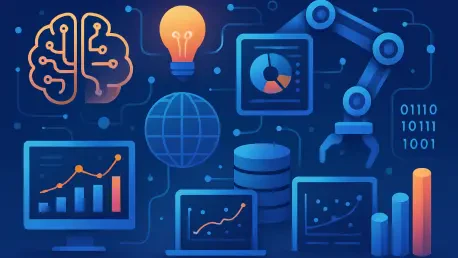The landscape of analytics and data science is undergoing a seismic shift this September, with groundbreaking innovations that are redefining how enterprises leverage data and artificial intelligence to drive decision-making. From unifying complex data ecosystems to ensuring AI tools are accessible to non-specialists, this month’s advancements reflect an industry striving to balance cutting-edge technology with practical, human-centered solutions. Drawing from the latest updates by industry pioneers, these developments address critical needs like scalability, accessibility, and operational efficiency while tackling the unintended consequences of rapid tech adoption. As businesses increasingly rely on data to navigate competitive markets, the strides made this month offer a compelling preview of a future where insights are not only powerful but also inclusive and sustainable. This exploration dives deep into the key trends and tools shaping the field, highlighting how they promise to transform enterprise strategies for the remainder of the year and beyond.
Unifying Data for Seamless AI Integration
The drive to consolidate fragmented data systems into cohesive platforms stands as a cornerstone of innovation in September. Cloudera has unveiled a significant upgrade to its platform, enabling unified data management across cloud, edge, and on-premises environments. This enhancement prioritizes secure, high-performance AI workloads, ensuring enterprises can process vast datasets with speed while adhering to compliance standards. It addresses a pressing industry demand for seamless integration, allowing businesses to extract actionable insights from diverse sources without the bottlenecks of siloed data. The focus on scalability ensures that as data volumes grow, organizations can maintain efficiency without overhauling their infrastructure, positioning this update as a vital tool for modern data-driven strategies.
Complementing this trend, MathCo’s introduction of SystemicAI offers a fresh approach to breaking down data barriers across key business functions like supply chain, finance, and customer engagement. This suite integrates disparate data streams for real-time analysis, providing a holistic view that empowers decision-makers to act swiftly on emerging trends. Unlike traditional tools that often isolate insights by department, SystemicAI fosters a connected ecosystem where cross-functional strategies can thrive. This development signals a broader industry shift toward eliminating silos, ensuring that data serves as a unified asset rather than a fragmented challenge. As enterprises grapple with increasingly complex environments, such solutions are proving indispensable for maintaining a competitive edge.
Democratizing AI and Analytics for Broader Reach
A notable theme this month is the push to make AI and analytics accessible to a wider audience, regardless of technical expertise. The collaboration between Databricks and OpenAI exemplifies this movement, delivering plug-and-play language models and codeless workflows tailored for enterprise data teams. This partnership reduces the complexity of integrating advanced AI into business processes, allowing teams to transition from raw data to actionable outcomes with minimal friction. By lowering the technical barrier, it enables even smaller organizations or those with limited resources to harness AI’s potential, reflecting a growing commitment to inclusivity in the tech space. Such advancements ensure that the benefits of AI are not confined to tech giants but are shared across diverse business landscapes.
In a similar vein, Power BI has rolled out browser-based tools for creating and editing semantic models, supporting over 100 connectors and extending compatibility to Mac users without the need for desktop software. This innovation prioritizes flexibility and ease of use, catering to a broad user base that may lack access to specialized hardware or deep technical skills. The emphasis on accessibility through browser-based solutions means that data modeling is no longer a niche activity but a capability within reach of various professionals across industries. This shift aligns with the industry’s goal of democratizing data tools, ensuring that insights can be generated and shared by a diverse array of stakeholders, ultimately fostering a more data-literate workforce.
Tackling Operational and Human Challenges in Tech Adoption
While technological advancements dominate headlines, attention is also turning to the operational and human challenges accompanying rapid innovation. A recent report from dbt Labs casts a spotlight on the issue of tool sprawl and shadow IT within enterprise analytics, highlighting how the proliferation of disconnected platforms contributes to analyst burnout. As data teams manage an ever-growing array of tools, the risk of inefficiency and mental strain becomes a critical concern. This insight serves as a reminder that innovation must be paired with simplicity to prevent overwhelming the very professionals tasked with driving data strategies. The industry is thus urged to streamline workflows, ensuring that new solutions enhance rather than hinder productivity.
Beyond burnout, the operational complexities of managing multiple tools underscore a broader need for cohesive systems that reduce friction. The dbt Labs findings point to the dangers of shadow IT, where unapproved tools create security risks and data inconsistencies across organizations. Addressing this requires a deliberate focus on integrating technologies into unified platforms that minimize redundancy while maintaining robust governance. Such an approach not only safeguards data integrity but also supports the well-being of data teams by reducing the cognitive load of navigating disparate systems. As the field evolves, balancing the excitement of new tools with the practicality of sustainable operations remains a pivotal challenge for enterprises aiming to scale their analytics capabilities.
Reinforcing the Value of Time-Tested Techniques
Amid the rush toward AI-driven solutions, the enduring relevance of foundational methods continues to shine through. Gurobi’s latest report on mathematical optimization emphasizes its critical role in enhancing applications ranging from machine learning to supply chain logistics and financial planning. These traditional techniques provide the precision and scalability necessary for modern AI systems to deliver reliable results, proving that innovation often builds on established frameworks. By optimizing complex processes, mathematical models enable faster and smarter decision-making, ensuring that enterprises can tackle intricate challenges with confidence. This perspective keeps the industry anchored, showing that cutting-edge progress does not always demand a complete departure from proven methodologies.
Further exploring this theme, the integration of mathematical optimization into contemporary tools reveals a synergy between old and new. As AI algorithms grow in sophistication, their effectiveness often hinges on the robust underpinnings of optimization techniques that ensure efficient resource allocation and error minimization. This blend of innovation and tradition offers a balanced approach to problem-solving, allowing businesses to leverage the best of both worlds. Whether refining predictive models or streamlining operational workflows, these foundational methods remain a linchpin for achieving sustainable outcomes. Their continued prominence serves as a testament to the idea that lasting progress in data science often rests on a deep respect for the principles that have long guided the field.
Pioneering Semantic Technologies for Intuitive Insights
Looking ahead, semantic technologies are emerging as a transformative force in bridging the gap between complex data models and practical business applications. ThoughtSpot’s advancement of an agentic semantic layer under the Open Semantic Interchange initiative marks a significant step in this direction. Designed to make data models more AI-ready and user-friendly, this framework simplifies how organizations interpret and act on their data. By enhancing the alignment between human understanding and machine processing, it paves the way for insights that are not only powerful but also intuitive, reducing the learning curve for non-technical users. This development signals a future where data interactions are more natural and less constrained by technical jargon.
Expanding on this vision, the focus on semantic layers addresses a critical need for adaptability in an era of rapid digital transformation. As businesses increasingly rely on AI to drive decisions, the ability to present data in a contextually relevant manner becomes paramount. ThoughtSpot’s initiative fosters an environment where data models evolve alongside business needs, ensuring that insights remain actionable amid changing priorities. This approach minimizes the friction often encountered when translating raw data into strategic plans, offering a glimpse into a landscape where technology serves as an enabler rather than a barrier. The rise of semantic technologies underscores a commitment to making data science not just a technical discipline but a universal tool for organizational growth.
Reflecting on a Month of Balanced Progress
Looking back on September’s developments, the analytics and data science sector demonstrated a remarkable ability to push boundaries while addressing practical constraints. Advances in data unification and AI accessibility tackled long-standing technical hurdles, empowering enterprises to transform raw information into strategic assets. At the same time, candid discussions around tool sprawl and analyst well-being reminded stakeholders of the human element at the core of these technologies. The reaffirmed importance of mathematical optimization and the pioneering strides in semantic frameworks rounded out a month that celebrated both innovation and pragmatism. Moving forward, the challenge lies in sustaining this balance—integrating powerful new tools with streamlined, user-focused systems. As the industry builds on these foundations, prioritizing collaboration and simplicity will be key to unlocking the full potential of data-driven decision-making in the months ahead.









